*NURSING > QUESTIONS & ANSWERS > PaEasy Hematology Questions and answers, 2022. Rated A+ (All)
PaEasy Hematology Questions and answers, 2022. Rated A+
Document Content and Description Below
PaEasy Hematology Questions and answers, 2022. Rated A+ Which of the following is one standard of care to treat a first-time deep vein thrombosis (DVT) without pulmonary embolism (PE)? A Begin... the patient on warfarin 5 mg PO once daily and check an INR in five days and adjust to therapeutic levels continuing warfarin for six months. B Begin the patient on enoxaparin 1 mg/kg SQ QD while also starting warfarin 5 mg PO once daily and check INR in five days and adjust to therapeutic levels continuing warfarin for six months and enoxaparin until therapeutic on the warfarin. C Begin the patient on enoxaparin 2 mg/kg SQ QD while also starting warfarin 5 mg PO once daily and check INR in five days and adjust to therapeutic levels continuing warfarin for six months and enoxaparin until therapeutic on the warfarin. D Begin the patient on heparin sodium IV and monitor and adjust levels to achieve therapeutic levels Q six hours and transition to warfarin as soon as possible. E Initiate a hypercoaguability work up and treat accordingly. - ✔✔Patients with deep vein thrombosis (DVT) without pulmonary embolism (PE) do not necessarily require hospitalization. Outpatient therapy would include treatment with a low molecular weight heparinoid (LMWH), such as enoxaparin, subcutaneously while the patient becomes therapeutic on oral warfarin. The LMWH can be discontinued once therapeutic on warfarin, with continued monitoring of INRs for six months before considering discontinuation. A 64-year-old, nonsmoking male presents to the clinic with complaints of headache and dizziness. Initial labs reveal hemoglobin of 20.1 g/dl, hematocrit of 60%, and platelet count of 567,000. Which of the following is the most likely diagnosis in this patient? A Acute myeloid leukemia B Chronic myeloid leukemia C Chronic obstructive pulmonary disease (COPD) D Multiple myeloma E Polycythemia vera - ✔✔Polycythemia Vera E Polycythemia vera often presents with complaints related to increased red blood cell mass, such as, headache, fatigue, and dizziness with elevated red blood cell mass with leukocytosis and/or thrombocytosis noted on CBC. Chronic hypoxia from conditions such as COPD (C) can also cause elevated RBC mass, but is unlikely in this non-smoker. The patient lacks white blood cell abnormality symptoms (e.g., recurrent infections, elevated white count) making acute myeloid leukemia (A), chronic myeloid leukemia (B), or multiple myeloma (D) unlikely diagnoses. A 23-year-old male with a recent diagnosis of Non-Hodgkin's lymphoma presents complaining of swelling of the neck and face, cough, and dyspnea on exertion. On exam you note dilated neck veins. Which of the following is the most likely diagnosis? A Angioedema B Carotid artery dissection C Cushing's syndrome D Myxedema E Superior vena cava syndrome - ✔✔Superior vena cava syndrome E The classic presentation signs and symptoms of superior vena cava syndrome (SVCS) are present in this patient. Although the most common cancer associated with SVCS is lung cancer, it also occurs in Non-Hodgkin's lymphoma. Angioedema (A), carotid artery dissection (B), Cushing's syndrome (C) and myxedema (D) can result in facial swelling, but should not lead to the presence of dilated neck veins. A 73-year-old, male with a 30 pack-year smoking history presents to the clinic with complaints of headache and dizziness. Labs reveal a hemoglobin of 21.3 g/dl, hematocrit of 63%, and platelet count of 498,000. He tests positive for the JAK2 mutation. Which of the following is the most appropriate treatment for the patient's suspected diagnosis? A Allopurinol B Anagrelide C Diphenhydramine D Hydroxyurea E Phlebotomy - ✔✔Phlebotomy E The first-line, and primary treatment for polycythemia vera is chronic phlebotomy. Patients who fail to improve or don't tolerate chronic phlebotomy can be treated with hydroxyurea (D), with anagrelide (B) being a third-line treatment. Allopurinol (A) may be necessary to treat hyperuricemia and gout. Diphenhydramine (C) may be used as symptomatic treatment for pruritus that doesn't improve with phlebotomy. A 53 year-old man with a past medical history of coronary artery disease, hypertension, diabetes, and allergic rhinitis is admitted to the hospital secondary to a non-ST elevation MI. On his second hospital day he develops severe thrombocytopenia with a platelet count of 17,000. Which of the following medications most likely caused his thrombocytopenia? A Atenolol B Erythromycin C Heparin D Loratadine E Metformin - ✔✔Heparin C Heparin (C) directly causes the production of heparin/PF4 antibodies that affect platelets, which leads to decreased platelet numbers, but an increased thrombosis risk. A 73-year-old, male with a 30 pack-year smoking history presents to the clinic with complaints of headache and dizziness. Labs reveal a hemoglobin of 21.3 g/dl, hematocrit of 63%, and platelet count of 498,000. He tests positive for the JAK2 mutation. Which of the following should be recommended to this patient to prevent secondary complications from his diagnosis? A Aspirin 81 mg daily B Ferrous Sulfate 325 mg twice daily C Eat a diet rich in vitamin B12 D Eat a diet rich in folate E Maintain stable consumption of foods that contain vitamin K - ✔✔Aspirin 81 mg daily A The patient most likely has polycythemia vera and is at risk for thrombotic events that can be reduced through the use of daily aspirin. In addition, he should be counseled on smoking cessation if he is still currently smoking. The patient should not take iron supplements (B) as they compete with phlebotomy therapy that seeks to reduce iron stores. Patient's with PCV similarly do not require vitamin B 12 (C) or folate (D) supplementation, and are not impacted by fluctuations in vitamin K consumption (E) unless they are being treated with warfarin for a current/recent thrombotic event. A 22-year-old non-obese female presents to the clinic with sign and symptoms of deep vein thrombosis (DVT). She denies recent trauma, prolonged immobilization, smoking, use of oral contraceptives, or changes in her health. Her last menstrual period was one week ago. Which of the following is the most likely diagnosis that contributed to the development of her DVT? A Antithrombin deficiency B Factor V Leiden C Protein C deficiency D Protein S deficiency E Hyperhomocysteinemia - ✔✔Factor V Leiden B Factor V Leiden mutation is one of the most common genetically inherited prothrombotic states. Deficiencies of antithrombin (A), protein C (C) and protein S (D) when homozygous in nature typically present as fetal death or severe thrombosis at birth. When heterozygous, they carry a much lesser risk of developing thrombosis as compared to Factor V Leidin. Hyperhomocysteinemia (E) also carries a much lesser risk of developing thrombosis. An 11-month-old African-American male presents to the pediatric office with lethargy, jaundice and splenomegaly. A CBC reveals hemoglobin of 8.0 mg/dl and a hematocrit of 25%. Peripheral smear appearance is available below. (shows sickle cells) Which of the following treatments will reduce hemolysis and increase hemoglobin levels for this patient? A Allogeneic stem cell transplant B Folic acid supplementation C Hydroxyurea D Prophylactic penicillin E Pneumococcal vaccine - ✔✔Hydroxyurea Hydroxyurea directly reduces hemolysis and increases levels of fetal hemoglobin and reduces complications and transfusion frequency. Sickle cell disease can be cured in 80% of individuals who receive a suitable transplant (A), but this procedure carries great risk and donors are difficult to identify. Folic acid supplementation (B) and pneumococcal vaccine (E) are indicated for preventive therapy of all patients with sickle cell disease, and prophylactic antibiotics (D) are used to prevent recurrent infections. A 67 year-old with chronic kidney disease presents to the clinic with a hemoglobin of 8.6 mg/dl and hematocrit of 24%. Which of the following agents, if administered, can further increase this patient's risk of thrombotic vascular events? A Cyanocobalamin B Erythropoietin C Ferrous sulfate D Folic acid E Niacin - ✔✔Erythropoietin Erythropoietin (B) increases red blood cell mass and toxicity may lead to increased blood viscosity and potential thrombotic events. Cyanocobalamin (A), ferrous sulfate (C), folic acid (D), and niacin (E) don't increase thrombotic risk. A 48-year-old female presents with a gradual progression of fatigue, pallor, and dyspnea on exertion over the last few months. Initial CBC results show a hemoglobin of 10.2 mg/dL, hematocrit of 31%, an MCV of 74 fL, and a reticulocyte count of 0.1%. After treatment for her anemia begins, which of the following diagnostic studies can be ordered first (earliest) to demonstrate a response to therapy? A Bone marrow aspirate B Ferritin C Hemoglobin/hematocrit D Iron binding capacity E Reticulocyte count - ✔✔Reticulocyte count The patient most likely has an underlying iron deficiency anemia (IDA) which requires confirmation and then evaluation for sources of chronic blood loss. IDA is treated with iron replacement (e.g., ferrous sulfate) and response to therapy can be assessed in 7-10 days via a reticulocyte count. The elevation of the reticulocyte count (after initial reticulocyte count was relatively low) at this time demonstrates the return of normal hemoglobin production (E). Bone marrow aspirate (A) would be an inappropriately invasive test to perform in this scenario. The patient's hemoglobin, hematocrit (C), MCV, and iron studies (B and D) will take a couple to a few months to return to normal. A 64-year-old, nonsmoking male presents to the clinic with complaints of headache and dizziness. Initial labs reveal hemoglobin of 20.1 g/dl, hematocrit of 60%, and platelet count of 567,000. Which of the following is the most likely physical exam finding in this patient? A Erythromelalgia B Hepatomegaly C Loss of vibratory sense D Petechiae E Splenomegaly - ✔✔Splenomegaly Splenomegaly is the most common physical exam finding in patients with polycythemia vera (PCV) and may be accompanied by hepatomegaly (B). Erythromelalgia (A) also occurs in patients with PCV due to increased red blood cell mass, but occurs less commonly than splenomegaly. Patients with PCV often have thrombocytosis, which most commonly contributes to thrombotic events, but less commonly may result in abnormal platelet function and petechiae (D) and increased bleeding risk. PCV is associated with elevated B 12 levels and not likely to result in the classic neurologic findings of B 12 deficiency including peripheral neuropathy assessed by vibratory sensation (C), ataxia and dementia. A 23 year-old woman seeks guidance on foods, medications, and supplements that can help increase the amount of iron supplement. Which of the following is the best advice to provide this patient? A Co-administer with a calcium supplement B Co-administer with proton pump inhibitors C Co-administer with vitamin C D Taking with a basic beverage E Taking with food - ✔✔Co-administration with Vitamin C An acidic achieved through presence of additional acids (C) (e.g., ascorbic acid) increases absorption of iron. Food (E), other heavy metals (A), and basic stomach environments (B, D) negatively affect the absorption of iron. A 48-year-old female presents with a gradual progression of fatigue, pallor, and dyspnea on exertion over the last few months. Initial CBC results show a hemoglobin of 10.2 mg/dL, hematocrit of 31%, an MCV of 74 fL, and a reticulocyte count of 0.1%. Which of the following is the most likely pathophysiologic mechanism responsible for her anemia? A Acute blood loss B Defective bone marrow/stem cell function C Defective DNA production D Defective hemoglobin production E Increased destruction of red blood cells - ✔✔Defective hemoglobin production The patient most likely has an underlying iron deficiency anemia (IDA), which requires confirmation and then evaluation for sources of chronic blood loss. IDA results from defective hemoglobin production. Acute blood loss (A) would present more acutely and with normal hemoglobin, hematocrit, and MCV until hemodilution occurs and lowers the hemoglobin concentration and hematocrit. Defective bone marrow/stem cell function (B) tends to produce normocytic red blood cells. Defective DNA production (C) results in failure of RBC maturation and macrocytosis (elevated MCV). Hemolysis (E) is less likely than IDA, but can be confirmed or ruled out through the assessment of iron studies, the reticulocyte count and further hematologic labs as necessary. A 63 year-old woman developed severe thrombocytopenia after undergoing her first treatment of a cisplatin-based chemotherapy regimen. Which of the following agents may be administered to prevent thrombocytopenia if the patient continues her cisplatin-based regimen? A Darbepoetin alfa (DARB) B Erythropoietin (EPO) C Filgrastim (G-CSF) D Oprelvekin (IL-11) E Sargramostim (GM-CSF) - ✔✔Oprelvekin, or recombinant interleukin-11, is a megakaryocyte growth factor that promotes platelet production. Erythropoietin (B) and darbepoetin alfa (A) are both stimulators of red blood cell production, while filgrastim (C) and sargramostim (E) stimulate granulocyte production. A 6-week-old male with sickle cell disease presents to the pediatric office for his well-child visit. When should this child begin taking daily prophylactic penicillin? A Now B 2 months C 6 months D 12 months E 5 years - ✔✔2 months Patients with sickle cell disease develop functional asplenia as early as 3 months of age and should begin treatment with prophylactic penicillin at 2 months of age to prevent infection by encapsulated organisms (i.e., pneumococcus). Discontinuation of therapy can be considered beginning about age 5 (E). A 28-year-old female presents with a gradual progression of fatigue and pallor over the last few months. Initial CBC results show a hemoglobin of 10.4 mg/dL, hematocrit of 32%, an MCV of 112 fL, and a reticulocyte count of 0.1%. Which of the following is the most likely pathophysiologic mechanism responsible for her anemia? A Chronic blood loss B Defective bone marrow/stem cell function C Defective DNA production D Defective hemoglobin production E Increased destruction of red blood cells - ✔✔Increased destruction of red blood cells The time course of the patient's presentation is consistent with multiple episodes of acute hemolysis. Defects in bone marrow (B) or red blood cell precursors (C and D) are refuted by the elevated reticulocyte count. Chronic blood loss (A) would have a more insidious, gradual onset and likely result in a decreased MCV. A 32 year-old obese woman presents to the clinic complaining of swelling, warmth, and redness of her left lower extremity. Doppler ultrasound confirms a deep venous thrombosis is the greater saphenous vein. Which of the following best describes the most likely pathophysiology underlying her thrombophilia? A Antithrombin deficiency B Increased plasma prothrombin C Protein C deficiency D Protein S deficiency E Resistance to activated protein C - ✔✔Resistance to activated protein C Factor V Leiden is a common genetic mutation that results in resistance to activated protein C. Increased plasma prothrombin concentration results from a prothrombin gene mutation (B), while deficiencies of antithrombin (A), protein C (C) and protein S (D) are rarer causes of prothrombotic states and are not directly associated with factor V Leiden mutation which is the most common cause of thrombophilia in this clinical scenario A 5 year-old girl presents to the clinic with her mother who is concerned about her daughter's energy level since starting full day kindergarten. CBC reveals a hemoglobin of 12.3 g/dl, hematocrit of 36%, MCV of 62 fL, and an MCHC of 34 g/dL. Serum ferritin levels are normal. What is the most likely hemoglobin electrophoresis results for this patient? A Decreased HbA2 and increased HbF levels B Decreased HbA2 and HbF levels C Increased HbA2 and normal HbF levels D Increased HbA2 and HbF levels E Normal HbA2 and HbF levels - ✔✔Normal HbA2 and HbF levels Alpha thalassemia presents with a normal hemoglobin electrophoresis, since all adult hemoglobin are alpha-containing and affected equally. Beta thalassemia major may present with increased HbA 2 and/or HbF levels (C and D). Beta thalassemia minor typically presents with increased HbA 2 (C). A 63-year-old female presents with deep bone pain in both legs. Laboratory evaluation reveals Bence-Jones proteinuria and a monoclonal spike on serum electrophoresis. Which of the following vaccines should this patient receive as part of her management? A Diphtheria B Human Papilloma Virus (HPV) C Pertussis D Pneumococcal E Varicella - ✔✔Pneumococcal D Patients with multiple myeloma are at risk from infections, especially from encapsulated organisms such as Haemophilus influenzae and pneumococcus. Pneumococcal vaccines should be administered, but the patient response is decreased based on their current immunodeficiency. DTaP (A and C), HPV (B), and varicella (E) vaccines are appropriate for this patient based on general immunization guidelines for adults, but not of increased necessity based on her diagnosis. A 6-month-old infant is brought to your office. The mother indicates that the infant had several scratches that took a long time to stop bleeding. After ruling out various forms of hemophilia, you suspect that the infant has a vitamin deficiency that is causing this problem. What proteins would be affected by this vitamin deficiency? Answer Choices 1 Protransglutaminase 2 Urokinase 3 Prekallikrein 4 Prothrombin 5 Fibrinogen - ✔✔prothrombin Prothrombin and many of the other blood clotting factors contain the modified amino acid γ-carboxyglutamic acid (gla). This modification occurs via an enzymatic reaction requiring vitamin K and converts glutamic acid, a weak calcium chelator [Show More]
Last updated: 1 year ago
Preview 1 out of 27 pages
Instant download

Buy this document to get the full access instantly
Instant Download Access after purchase
Add to cartInstant download
Also available in bundle (1)

PA easy bundle, Exam Questions and answers, Rated A+
Comprises of exam Questions and answers, latest revisions for exams
By bundleHub Solution guider 1 year ago
$38
11
Reviews( 0 )
Document information
Connected school, study & course
About the document
Uploaded On
Aug 22, 2022
Number of pages
27
Written in
Additional information
This document has been written for:
Uploaded
Aug 22, 2022
Downloads
0
Views
101












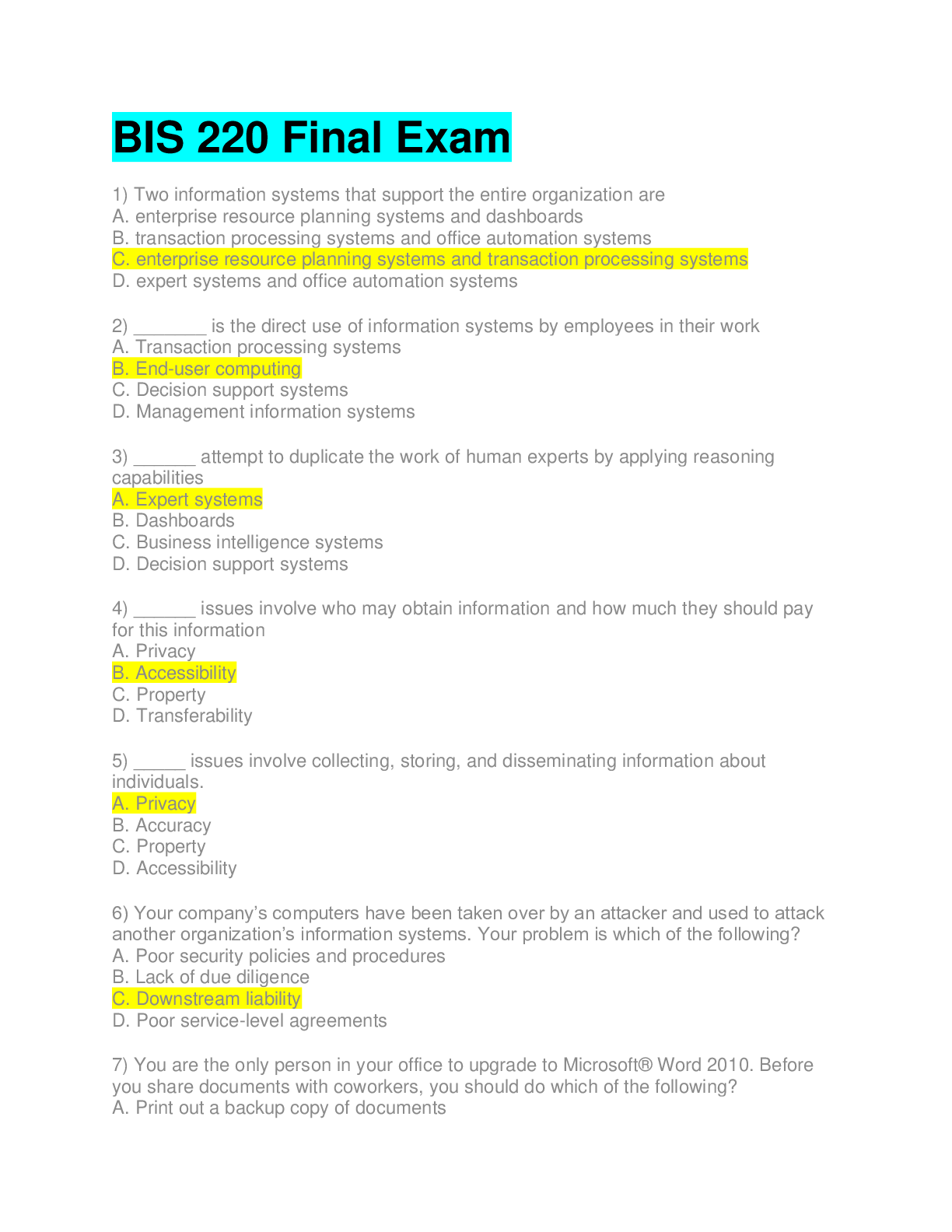

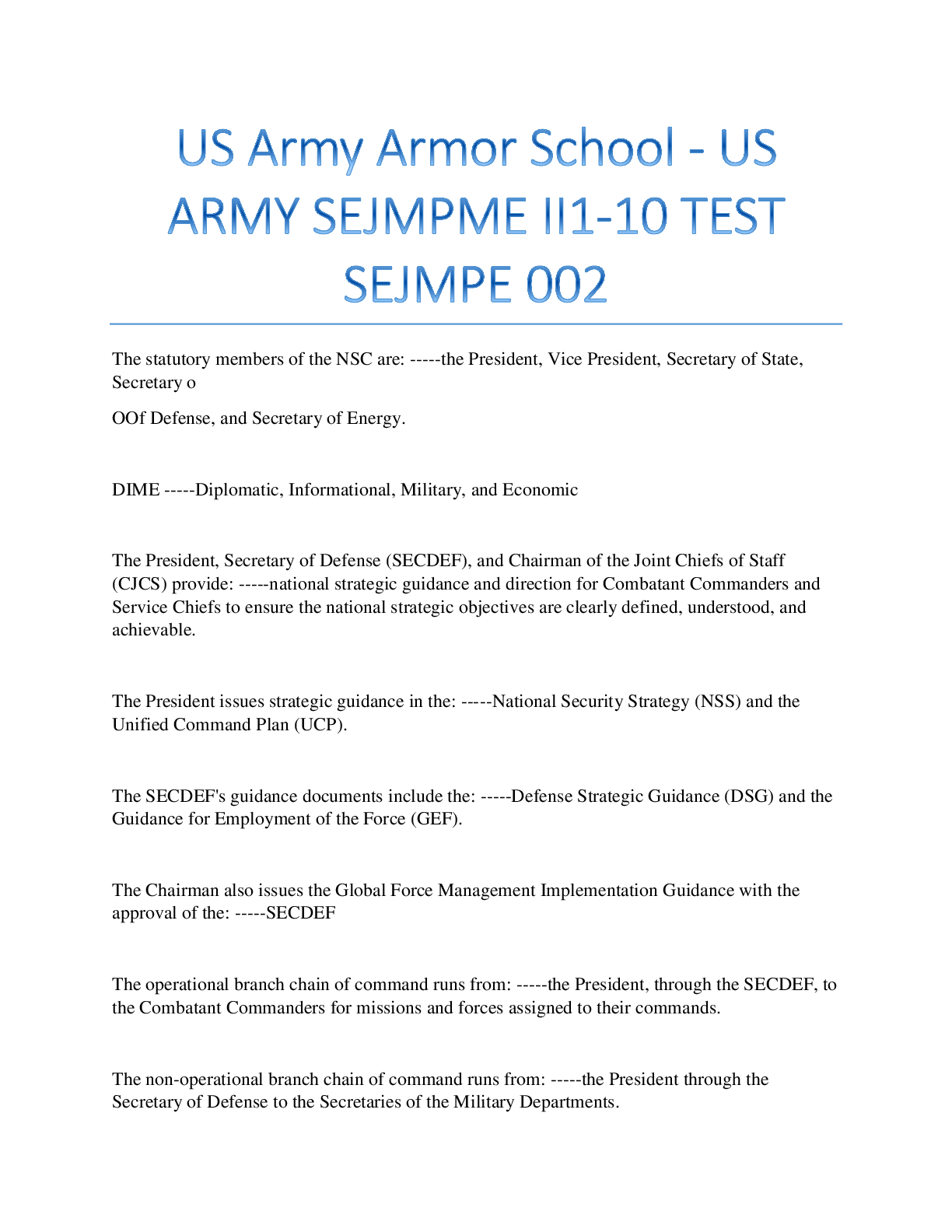



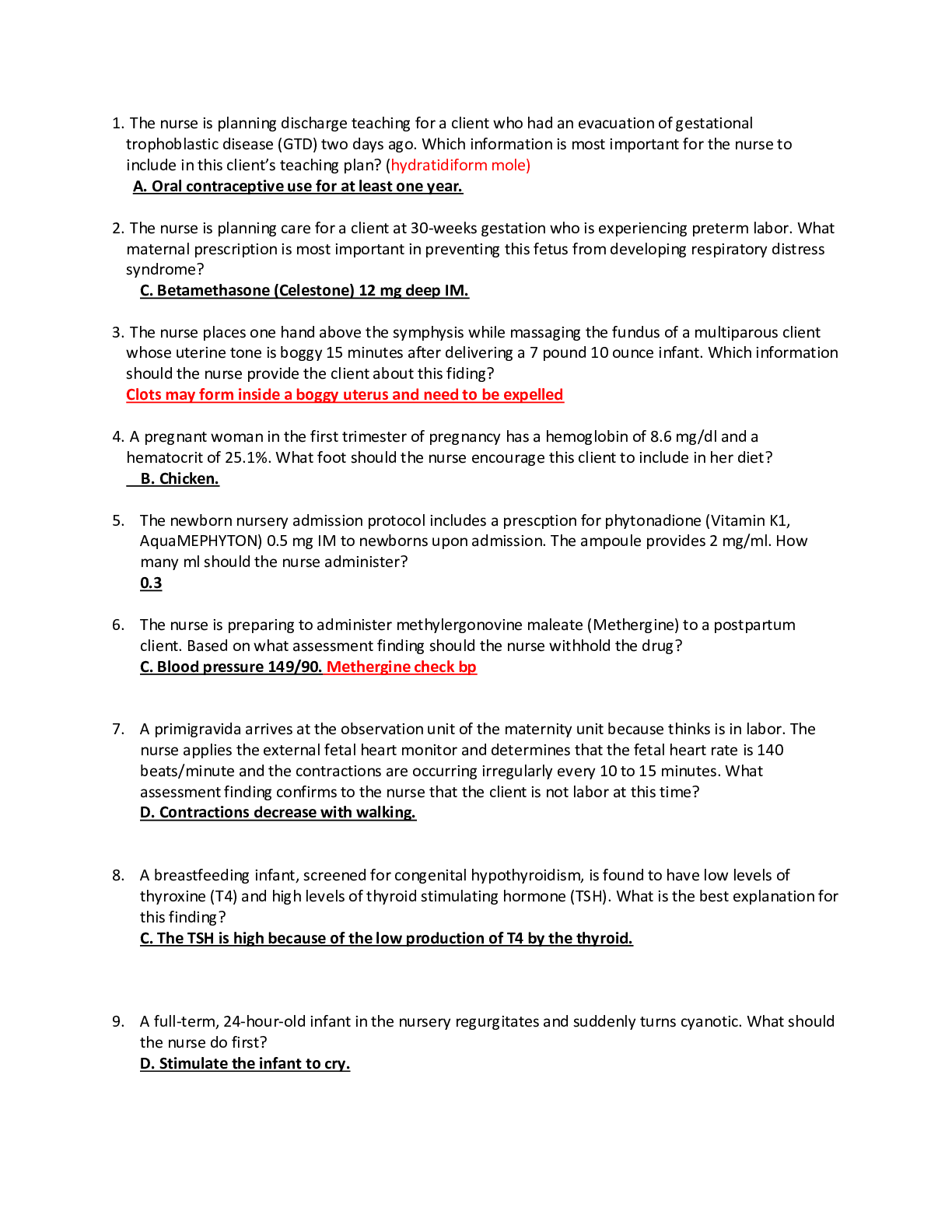
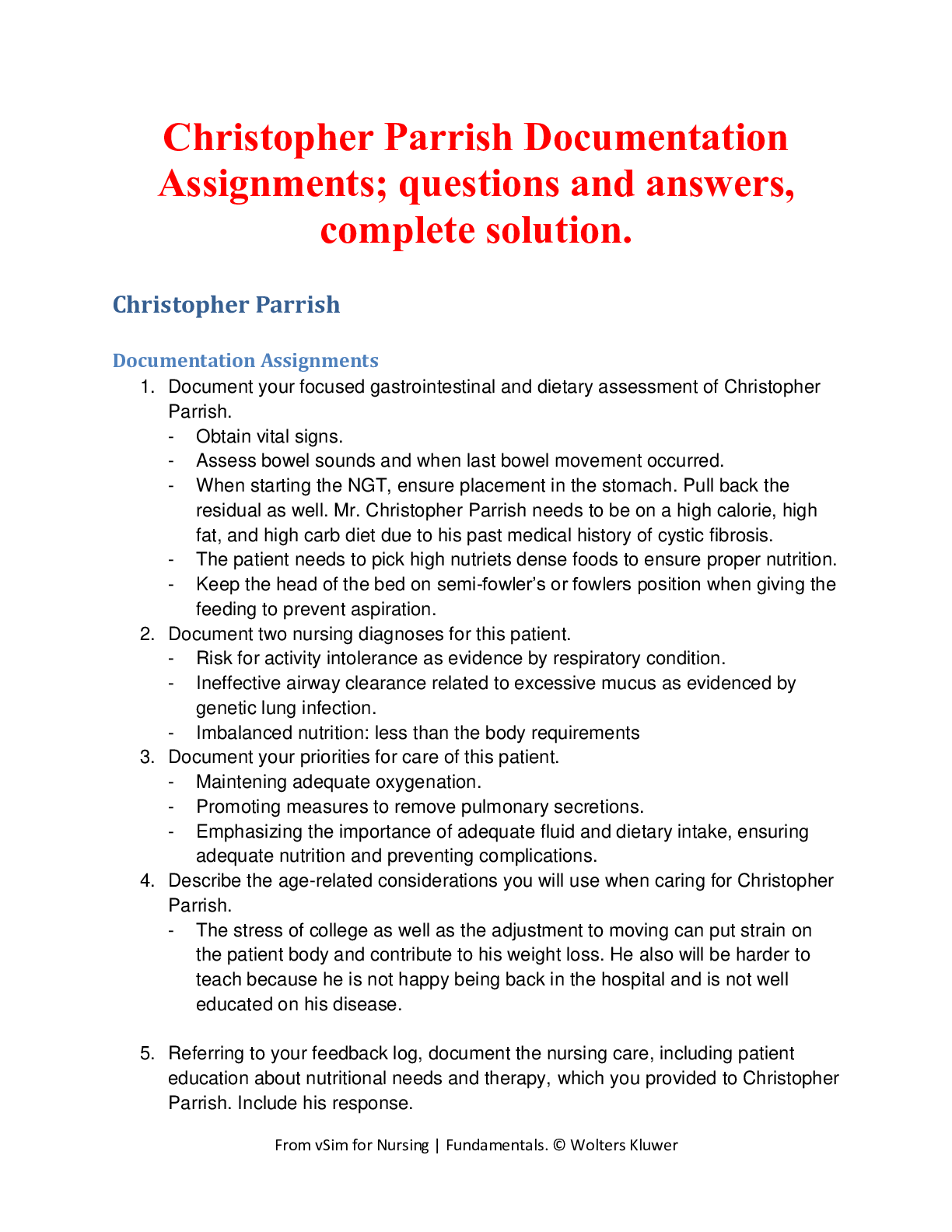
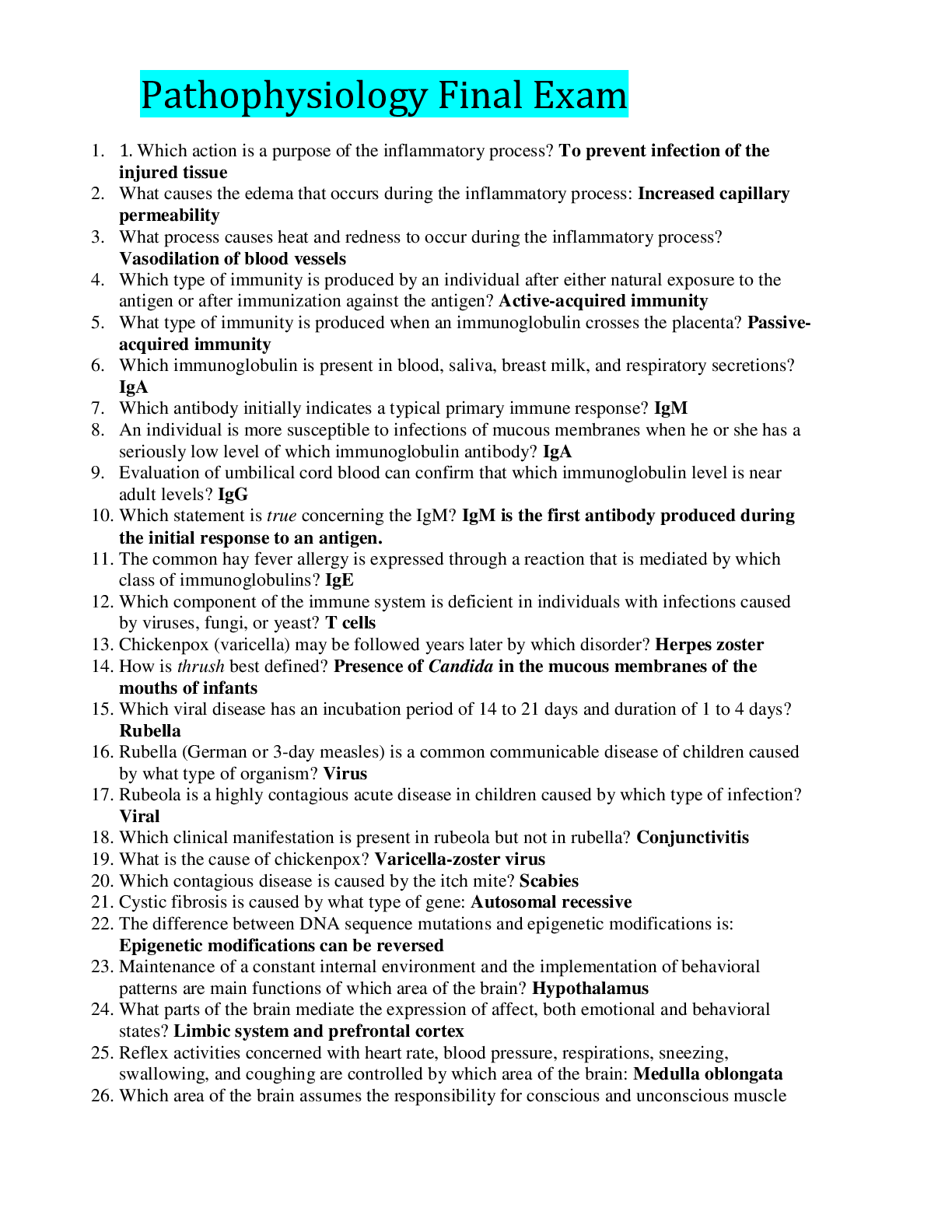
.png)



